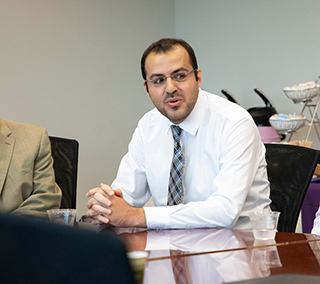Space-Borne Remote Sensing and a New Age of Discovery
 |
|
Assistant Professor Mustafa Aksoy will speak on “A New Age of Discovery: This Time from Space,” about how remote sensing instruments are rapidly expanding our knowledge of the worlds beyond our own. |
ALBANY, N.Y. (Nov. 19, 2020) – The “Age of Discovery,” a period of time in which European explorers circumnavigated the globe, expanded trade routes and established colonies on distant lands, forever reshaped the world. Now, a new age of discovery is upon us, as science and technology provides new tools for humans to explore the solar system and the space beyond.
At 3 p.m. today, the Division for Research will host its November Research Coffee Hour, featuring a webinar by Assistant Professor of Electrical and Computer Engineering Mustafa Aksoy. His lecture, “A New Age of Discovery: This Time from Space,” will address how remote sensing instruments are rapidly expanding our knowledge of the worlds beyond our own.
 |
|
Assistant Professor of Electrical and Computer Engineering Mustafa Aksoy |
“Remote sensing systems are capable of traveling long distances onboard space vehicles and measuring critical geophysical parameters over large areas form the backbone of space exploration,” said Aksoy, whose research focuses on remote geophysical sensing using microwave technology and electromagnetic theory at the College of Engineering and Applied Sciences.
In the talk, Aksoy will discuss his motivation to study space science and technologies as well as his recent research in the field of space-borne remote sensing.
Aksoy’s webinar will run from 3 to 4:30 p.m., and can be joined via Zoom.
This year, the Research Coffee Hour is celebrating Diversity in Research Excellence at UAlbany. The Division for Research is featuring faculty from throughout the University discussing the factors that led to the choice of their career, and steps they took to achieve success.
Aksoy joined the faculty of the Department of Electrical and Computer Engineering in Fall 2017. He received his PhD in 2015 from Ohio State University, where he worked as a graduate research associate at the ElectroScience Laboratory.
Prior to joining UAlbany, Aksoy was a post-doctoral research associate at the University of Maryland Baltimore County and NASA Goddard Space Flight Center. In 2019, Aksoy was selected to receive one of NASA’s early career awards to study early-stage space technologies. Aksoy’s focus is on radiometers onboard spacecraft, which can measure everything from moisture in soil on Earth to surface temperatures on the Moon. He is also using machine-learning algorithms to develop a new, easier way to calibrate large constellations of CubeSats carrying this type of instrument.
Aksoy is a member of the Institute of Electrical and Electronics Engineers (IEEE), the IEEE Geoscience and Remote Sensing Society (GRSS), and the IEEE Geoscience and Remote Sensing Society’s Frequency Allocations in Remote Sensing (FARS) Committee. He also serves as a reviewer for many journals such as the IEEE Transactions on Geoscience and Remote Sensing (TGRS), and IEEE Geoscience and Remote Sensing Letters (GRSL).
![]() For more news, subscribe to UAlbany's RSS headline feeds
For more news, subscribe to UAlbany's RSS headline feeds
A comprehensive public research university, the University at Albany-SUNY offers more than 120 undergraduate majors and minors and 125 master's, doctoral and graduate certificate programs. UAlbany is a leader among all New York State colleges and universities in such diverse fields as atmospheric and environmental sciences, business, education, public health,health sciences, criminal justice, emergency preparedness, engineering and applied sciences, informatics, public administration, social welfare and sociology, taught by an extensive roster of faculty experts. It also offers expanded academic and research opportunities for students through an affiliation with Albany Law School. With a curriculum enhanced by 600 study-abroad opportunities, UAlbany launches great careers.


